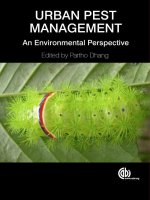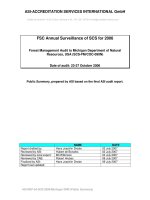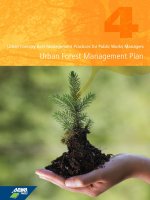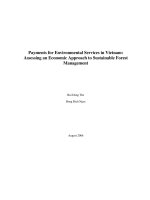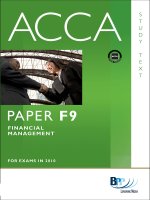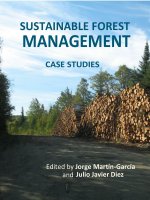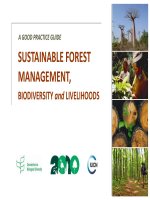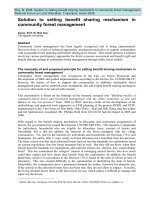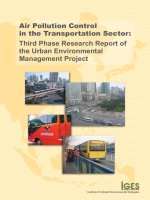Urban forest management study
Bạn đang xem bản rút gọn của tài liệu. Xem và tải ngay bản đầy đủ của tài liệu tại đây (681.63 KB, 21 trang )
Urban Forest Strategic Plan for the City of Peterborough
Urban Forest Management
Urban Forest Management includes the efforts made by municipal,
corporate (including all forms of local businesses) and private citizens in
the study and management of the urban forestry. Policies, by-laws, and
standards for tree planting and care; long and short term plans;
inclusion of tree inventory; deployment of qualified/trained staff; plant
health care and integrated pest management; heritage, memorial and
commemorative trees; hardy species; variety; succession planting;
suitability; planting and care of school grounds are all components of
urban forest management. An urban forest strategic plan establishes
the foundations for the application of best management practices that
will benefit our community.
Urban Forest Strategic Plan for the City of Peterborough
Purpose
The urban forest provides many benefits including social, cultural,
economic, environmental and engineering benefits. Increasing attention
to global warming and the need to address sustainability in our
community focuses ever increasing attention to the importance of trees
and the urban forest.
In 1988, the City established a Forestry Resource Management policy
to provide direction to the practice of urban forest management. Since
that time there have been numerous changes in the forestry
management field, including greater public involvement and legislative
amendments.
Goal
The goal of the Urban Forest Strategic Plan is to review and update the
1988 policy and to begin the process of long term strategic planning.
Urban Forest Strategic Plan for the City of Peterborough
How We Developed Our Plan.
In 2007 two committees were created to discuss and provide guidance
for the New Urban Forest Strategic Plan; a Technical Advisory
Committee (TAC) and a stakeholder committee (SHC).
Technical Advisory Committee Participants
• Public Works, Parks and Forestry
• Utility Services, Engineering and Construction
• Land Information Services
• Planning and Development Services
• Community Services
• Peterborough Green-Up
• Ministry of Natural Resources
• Otonabee Conservation
Urban Forest Strategic Plan for the City of Peterborough
Stakeholder Committee Participants
• Fleming College
• Trent University
• Peterborough Home Builders Association
• City of Peterborough, Legal Services
• Peterborough Utility Services Inc
• Parks Canada, Trent Severn Waterway
• Peterborough Field Naturalists
• Kawartha Heritage Conservancy
• Independent Consulting Arborist
Initial Topics for Discussion
• Vision Statement
• Tree Protection
• Sustainable Health and Enhancement
• Education and Public Involvement
• Management, Maintenance and Care
Urban Forest Strategic Plan for the City of Peterborough
The Urban Forest Strategic Plan
The Technical Advisory Committee and the Stakeholders Committee
advanced a common vision to guide the Urban Forest Strategic Plan.
“Peterborough highly values the vital contribution of the
trees that make up the urban forest on both private and
public lands to the environmental, social, cultural and
economic well being for all.
To safeguard the benefits provided by the urban forest,
the City is committed to working in partnership with the
community, to develop and implement an ongoing
management strategy with measurable outcomes. This
will promote community stewardship and best urban
forest management practices to preserve, enhance and
renew this essential natural resource.”
Urban Forest Strategic Plan for the City of Peterborough
Strategic Objectives
Through the course of regular TAC and SHC meetings, key strategic
objectives for managing the urban forest were developed. The
recommended the plan relies on the following strategic objectives:
1. To maintain and enhance a sustainable urban forest within the City of
Peterborough.
2. To maximize the benefits of the urban forest for the well being of the
community.
3. To formalize and enhance the City’s roles and accountability as a
steward, manager, promoter and administrator of the urban forest.
4. To recognize and manage the urban forest as a critical element of the
City’s green infrastructure.
5. To preserve and protect the health of the existing urban forest and
prevent unnecessary damage or removal.
6. To identify and preserve significant trees based on historic, aesthetic,
cultural, social, scientific and ecological criteria.
7. To create an administrative framework that includes ongoing
monitoring and assessment
8.
To increase community awareness of the benefits of trees, encourage
the community’s involvement, and create a shared sense of
responsibility for the stewardship of the urban forest.
Urban Forest Strategic Plan for the City of Peterborough
Recommendations
To meet the strategic objectives of the report, the TAC and SHC
developed
recommendations
to
facilitate
reaching
the
desired
outcomes. The strategic objective and associated recommendations
follow.
Urban Forest Strategic Plan for the City of Peterborough
1) To maintain and enhance a sustainable urban forest
within the City of Peterborough.
Recommendation 1.1:
Develop and implement management targets and strategies for
natural areas, parks, street trees, and private trees, industrial,
commercial and institutional areas.
Recommendation 1.2:
Conduct periodic inventories of the urban forest within prescribed
timelines for street trees, specimen park trees, representative
samples of privately owned trees in each of the City's
maintenance zones, and integrate with the City's GIS system.
Conduct plot samples and apply a recognized classification
system for natural areas.
Recommendation 1.3:
Genetic diversity can be enhanced by including open-pollinated
trees from local seed sources wherever possible. Set percentage
limits for cultivars, species and genera to encourage biodiversity
in new tree planting programs.
Recommendation 1.4:
Establish targets for native species composition in various land
use classes.
Recommendation 1.5:
Encourage the production of high quality native trees by regional
nurseries grown from local genetic seed sources.
Urban Forest Strategic Plan for the City of Peterborough
Recommendation 1.6:
Create and maintain a list of recommended native and exotic tree
species in a variety of height classes, and make this list available
to City staff, local garden centres, community groups and individual
property owners. The list should include information about mature
size, site requirements and unique maintenance needs for each.
Recommendation 1.7:
Implement trials with Carolinian tree species in public parks, and
enhance percentages of storm resistant species in future plantings.
Recommendation 1.8:
Develop response plans for severe weather events including high
winds, ice storms and drought to minimize impact on the longterm health of the urban forest.
Recommendation 1.9:
Create and maintain corridors of mature trees as connecting links
between natural areas in the City.
Recommendation 1.10:
Restore and enhance canopy cover and improve ecological function
in degraded open spaces.
Urban Forest Strategic Plan for the City of Peterborough
2) To maximize the benefits of the urban forest for the well
being of the community.
Recommendation 2.1:
Establish a baseline of total canopy cover in the City of
Peterborough and update: 1) periodically or 2) with each upgrade
in City Aerial Photographs.
Recommendation 2.2:
Increase the amount of space available for tree planting in all new
site and subdivision developments.
Recommendation 2.3:
Identify suitable planting locations to sustain large trees, and provide
the environmental conditions to enable them to reach maturity.
Recommendation 2.4:
Seek opportunities for planting and protecting groves of
recommended species on public and private land to help mitigate the
impacts of climate change.
Urban Forest Strategic Plan for the City of Peterborough
3) To formalize and enhance the City’s roles and
accountability as a steward, manager, promoter and
administrator of the urban forest.
Recommendation 3.1:
Provide sufficient qualified forestry personnel, equipment, and
other supporting resources for planned management programs of
the urban forest. Recommend budget requirements for increased
equipment software and inventory mechanisms to fulfill the
objectives of the Urban Forest Strategic Plan.
Recommendation 3.2:
Develop and update forestry-training programs, provide
professional memberships for forestry personnel.
Recommendation 3.3:
Investigate providing line clearing services to Peterborough Utility
Services Inc. and other opportunities for strategic alliances.
Recommendation 3.4:
Participate in professional associations and extend professional
relationships with other municipalities to share urban forest best
management practices.
Urban Forest Strategic Plan for the City of Peterborough
Recommendation 3.5:
Develop and maintain a common information system on forested
areas, street, heritage trees and invasive species within the City
and require for new developments, consultants provide
information in compatible format.
Recommendation 3.6:
Track, monitor, evaluate and communicate the progress of the
Urban Forest Strategic Plan including criteria and performance
indicators.
Recommendation 3.7:
Develop a 20-year management strategy with a series of 5-year
management goals, targets and assessment tools. Annual
operations will reflect current priorities and respond to ongoing
monitoring and evaluation of the condition and sustainability of
Peterborough’s urban forest.
Recommendation 3.8:
Set up various departmental, individual and adhered roles and
responsibilities for the management of the urban forest.
Urban Forest Strategic Plan for the City of Peterborough
4) To recognize and manage the urban forest as a critical
element of the City’s green infrastructure.
Recommendation 4.1:
Recognize the urban forest as a critical element of the City’ green
infrastructure in the Official Plan.
Recommendation 4.2:
Develop and promote the value and contribution that the urban
forest provides to the health and well being of the community.
Recommendation 4.3:
Invest in a corporate compatible asset management program for
trees that combines tree inventories, GIS spatial/asset information,
and work order tracking capabilities.
Recommendation 4.4:
Monitor and assess the performance of the urban forest through the
use of models such as the Urban Forest Effects Model (UFORE).
Recommendation 4.5:
Relate the Urban Forest Strategic Plan to other sustainability,
environmental and land use planning initiatives.
Recommendation 4.6:
Develop requirements and incentives for planting and maintaining
trees to cool and act as windbreaks for residential commercial and
public spaces.
Urban Forest Strategic Plan for the City of Peterborough
Recommendation 4.7:
Undertake a study to identify canopy cover targets for land use
classes as described in the Official Plan. These targets will be used
to identify opportunistic locations to increase tree planting in order to
meet the canopy cover targets.
Urban Forest Strategic Plan for the City of Peterborough
5) To preserve and protect the health of the existing
urban forest and prevent unnecessary damage or
removal.
Recommendation 5.1:
Investigate a permitting process for removal of sound trees in the
city.
Recommendation 5.2:
Introduce regular inspection cycles and utilize inventory data of city
owned trees to establish cyclic maintenance programs and a system
of work order priority.
Recommendation 5.3
Identify and inform all stakeholders in the urban forest of the nature
of invasive species, the potential for damage and preventable
actions. Include adaptive management principles within the urban
forestry management plan to monitor, prevent and respond to
threats from invasive species in co-operation with all stakeholders.
Recommendation 5.4
Establish a committee of city departments and utility representatives
to develop a code of practice to ensure the protection of trees during
installation and/or maintenance of grey infrastructure and services.
Recommendation 5.5:
Produce a guidance document for planners, developers and
architects on trees and development that includes minimum
protection distances and methods of tree protection during the
entire development process.
Urban Forest Strategic Plan for the City of Peterborough
Recommendation 5.6
Adopt an industry- approved method of risk assessment that
protects the public while considering all of the needs of the urban
forest, implemented by certified or licensed personnel.
Recommendation 5.7:
Reinstate the Natural Areas Committee or an environmental or
sustainability committee to oversee the management and protection
of designated natural areas in the city with proactive and planning
review mandate.
Urban Forest Strategic Plan for the City of Peterborough
6) To identify and preserve significant trees based on
historic, aesthetic, cultural, social, scientific and
ecological criteria.
Recommendation 6.1
Implement a heritage tree identification, designation and protection
program based on the Ontario Heritage Tree Act and the
standards recommended by the Ontario Heritage Tree Alliance.
Recommendation 6.2:
Investigate economic incentives for landowners with designated
heritage trees on their property.
Recommendation 6.3:
Implement a seed collection and propagation program in
cooperation with regional nurseries to preserve the genetic
heritage of significant trees in the City.
Urban Forest Strategic Plan for the City of Peterborough
7) To create an administrative framework that includes
ongoing monitoring and assessment.
Recommendation 7.1:
Include the term ‘Urban Forest’ in section 9.8, Interpretation, of the
Official Plan.
Recommendation 7.2:
Amend the Official Plan to include a section directly related to the
Urban Forest and that the Urban Forest Strategic Plan for the City
of Peterborough be recognized as the mechanism by which urban
forest management is guided.
Recommendation 7.3:
That all sections of Official Plan that have direct inference to, and
are affected by, the Urban Forest be reviewed and updated to
recognize and include the term Urban Forest.
Recommendation 7.4:
Investigate developing a bylaw to maintain the Urban forest with no
net loss.
Recommendation 7.5:
Implement a mechanism for replacing losses to the urban forest,
either on the developed site, at an offsite location directed by the
City or by providing a monetary contribution to a reserve fund. The
reserve fund will be designated for the planting of trees on City
owned lands to replace leaf area lost through development and
construction.
Urban Forest Strategic Plan for the City of Peterborough
Recommendation 7.6:
Amend the City’s tree by-laws to create a permitting process for
protecting and preserving trees on public and private property.
These standards need to incorporate accepted valuation of tree
methods for assessing compensatory payments for the removal of
any tree.
Recommendation 7.7:
All applications for Committee of Adjustment approval, that will
impact the health and condition of significant trees, and also
require site plan control approval be required to provide an arborist
report (health, condition and value) and site visit by City staff prior
to Committee of Adjustment approval.
Recommendation 7.8:
Implement and enforce development standards regarding the
preservation, protection and enhancements of the urban forest to
be followed during site development and construction projects.
Recommendation7.9:
Hire a certified Arborist to review and enforce tree protection on
development sites, private property and City of Peterborough public
lands.
Recommendation 7.10:
Create an incentive program for developers who, through creative
planning, develop sites that preserve and protect the integrity of
existing significant trees and associated grades, natural features and
functions.
Urban Forest Strategic Plan for the City of Peterborough
8) To increase community awareness of the benefits of
trees, encourage the community’s involvement, and
create a shared sense of responsibility for the
stewardship of the urban forest.
Recommendation 8.1:
Work with community stakeholders to identify educational needs and
provide suitable resources about the urban forest for City Council and
staff, construction companies, homeowners, developers, woodlot
owners, the business community, children and youth to become more
knowledgeable about the urban forest.
Recommendation 8.2:
Provide public access to up-to-date information through a City
Forestry web page that includes:
benefits of trees;
tree by-laws (protection, preservation, permits,
penalties);
planting requests and species availability for public
rights-of-way;
species selection, planting, aftercare and long term
maintenance on private property;
dealing with invasive species;
pruning and removal requests, process and
response time;
tree ownership;
City and community programs;
links to other organizations;
incentives and support;
conserving private natural areas
Urban Forest Strategic Plan for the City of Peterborough
Recommendation 8.3:
Work with community stakeholders to provide a variety of incentives
and support services to encourage stewardship of the urban forest
including:
neighbourhood fundraising, tree planting and
maintenance programs;
sponsorship of urban forest initiatives by the
commercial sector;
public tree care workshops;
public participation in neighbourhood tree inventories;
incentives for tree planting and stewardship in
schoolyards and public parks;
recognition of volunteer efforts.
Recommendation 8.4:
Sustain strategic alliances with stakeholder organizations to
maximize collective impact of communications, community
engagement, and resource protection and enhancement initiatives.
Stakeholders include government agencies, utility providers,
schools, large landowners, NGOs, businesses, corporations and
neighbourhood associations.
